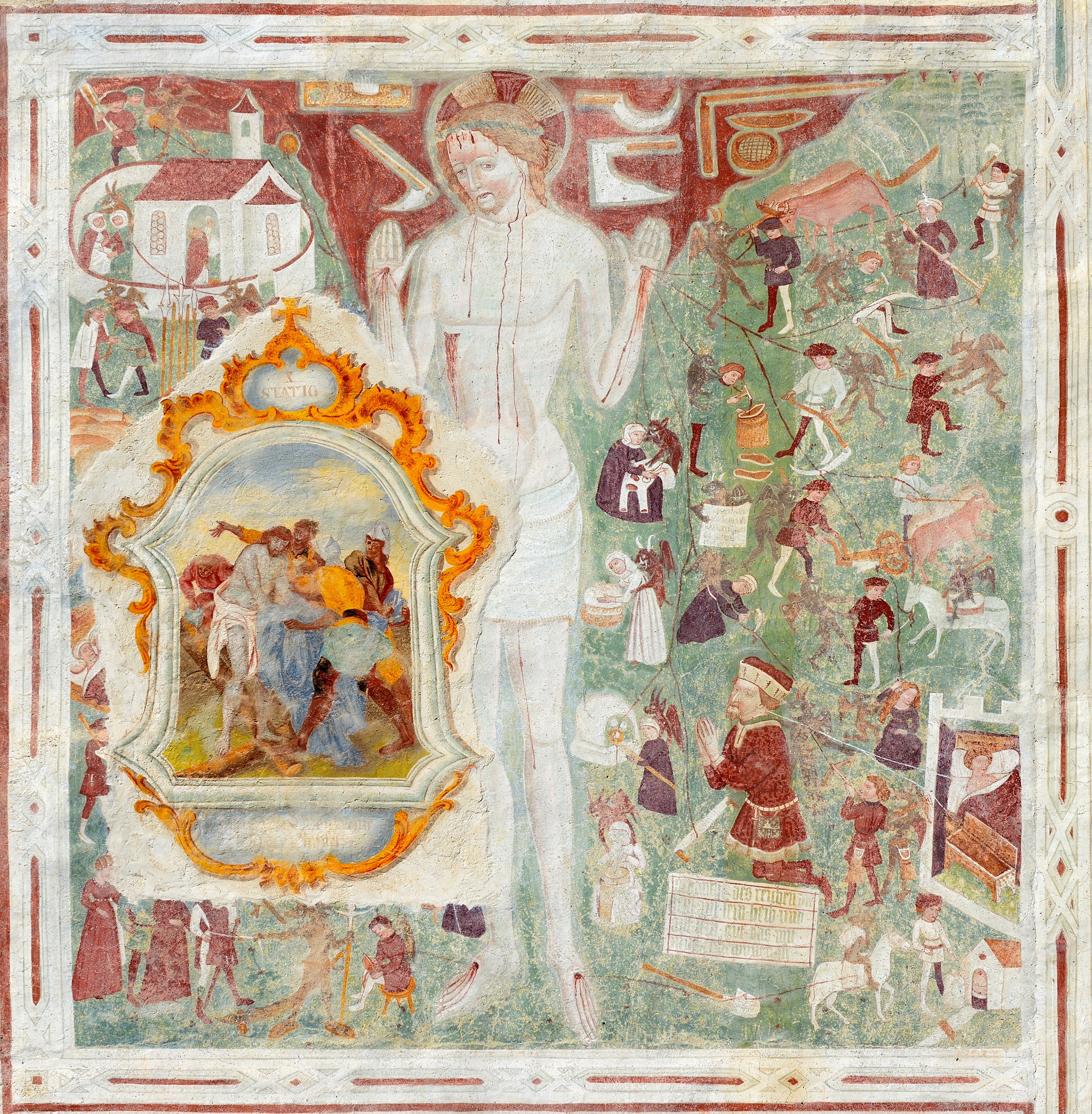Sunday Christ on:
[Wikipedia]
[Google]
[Amazon]
 The Sunday Christ is a gigantic figure in mediaeval church wall painting, intended to discourage
The Sunday Christ is a gigantic figure in mediaeval church wall painting, intended to discourage
 The Sunday Christ is a gigantic figure in mediaeval church wall painting, intended to discourage
The Sunday Christ is a gigantic figure in mediaeval church wall painting, intended to discourage sabbath
In Abrahamic religions, the Sabbath () or Shabbat (from Hebrew ) is a day set aside for rest and worship. According to the Book of Exodus, the Sabbath is a day of rest on the seventh day, commanded by God to be kept as a holy day of rest, as G ...
-breaking and blasphemy
Blasphemy is a speech crime and religious crime usually defined as an utterance that shows contempt, disrespects or insults a deity, an object considered sacred or something considered inviolable. Some religions regard blasphemy as a religiou ...
. It is not known in stained glass
Stained glass is coloured glass as a material or works created from it. Throughout its thousand-year history, the term has been applied almost exclusively to the windows of churches and other significant religious buildings. Although tradition ...
or manuscripts
A manuscript (abbreviated MS for singular and MSS for plural) was, traditionally, any document written by hand – or, once practical typewriters became available, typewritten – as opposed to mechanically printed or reproduced in ...
. The Sunday Christ is also known as 'Feiertagschristus' in German, 'Christ du Dimanche' in French, 'Cristo della domenica' in Italian, and 'Sveta nedelja' in Slovenian.
These painted images, dating from the mid-fourteenth to the mid-sixteenth century, occur in clusters in two geographically distinct areas, namely southern England and Wales, and the Alpine regions of France, Germany, Austria, Switzerland, Slovenia and northern Italy. Some isolated examples also appear in Bohemia and on the Baltic coast. The fresco in the church in San Pietro di Feletto
San Pietro di Feletto is a ''comune'' (municipality) in the Province of Treviso in the Italian region Veneto, located about north of Venice and about north of Treviso.
Main sights
The ''Pieve
In the Middle Ages, a pieve (, ; la, plebe, lin ...
in north east Italy is a particularly fine example. A very good surviving English example is in Breage in Cornwall, with another in St Just in Penwith nearby. Yet another fine English example is to be found in Hessett
Hessett is a village and civil parish in the Mid Suffolk district of Suffolk in eastern England. Hessett is located around four miles south-east of Bury St Edmunds. It is a rural village with a single north-south road off which most other roads ...
church in Suffolk. An example from Wales can be found at St Cybi's Church, Llangybi, Monmouthshire
The Church of St Cybi, Llangybi, Monmouthshire is a parish church with its origins in the 13th or 14th century. Refurbished in the 15th century, the church was restored in 1909–10. The interior has a notable collection of medieval wall paint ...
.
All these figures show Christ as a central '' Man of Sorrows'' surrounded by objects, often the tools of various trades, such as axes, knives, scissors, mill-wheels, or a pair of scales, all of which are wounding Christ afresh. Objects with blades or sharp points have these pointing towards Christ, and blood can be seen dripping or even spurting in jets from fresh wounds caused by these. This fresh suffering of Christ has strong echoes of the Song of the Suffering Servant in Isaiah 53.
The appearance of these depictions is thought to have followed the Black Death
The Black Death (also known as the Pestilence, the Great Mortality or the Plague) was a bubonic plague pandemic occurring in Western Eurasia and North Africa from 1346 to 1353. It is the most fatal pandemic recorded in human history, causi ...
, which peaked in Europe 1348-1350. In the aftermath of the plague, many more Days of Obligation were declared by the church. These were days when all people were supposed to go to Mass, and ''to abstain from those works and affairs which hinder the worship to be rendered to God''. But for many tradespeople, the sheer number of such days meant that they had to work during them to be able to make a living. These depictions of Christ were intended to give a vivid warning to those who worked on days of obligation that they were re-crucifying Christ by their actions.
In medieval times, catechetical wall paintings were used to illustrate various teachings of the Catholic church. Many were simply artistic representations of stories, and others were simplifications of theological ideas - the seven deadly sins and the seven cardinal virtues, for example. Some warn against various occasions of sin, such as the Sabbath Breaking implicit in working on a Day of Obligation. Generally, wall paintings provided a local site for discussion and exemplification.
In Victorian times, these graphic images were reinterpreted, often referred to as ''Christ of the Trades'', and were described as showing Christ blessing the tools of various trades. However, the way that Christ always has fresh wounds associated with some of the tools is at odds with such an interpretation.
References
External links
{{commons, Sunday Christ Medieval art